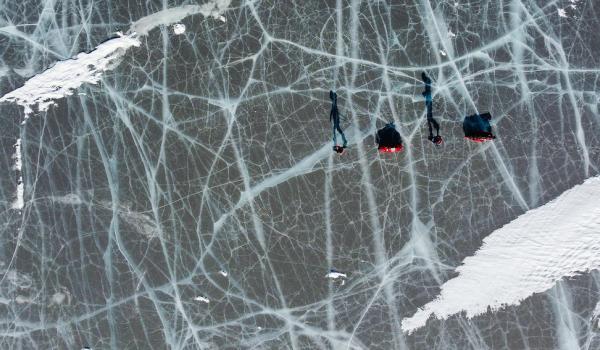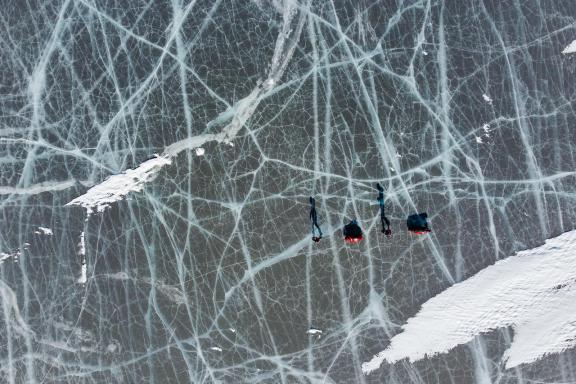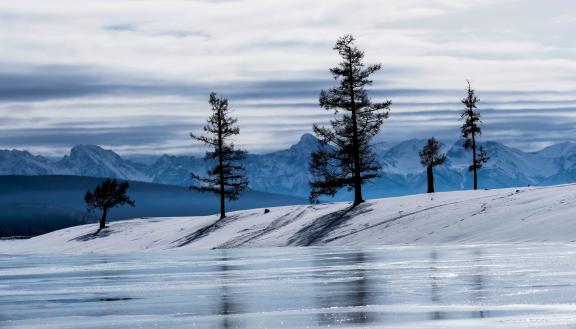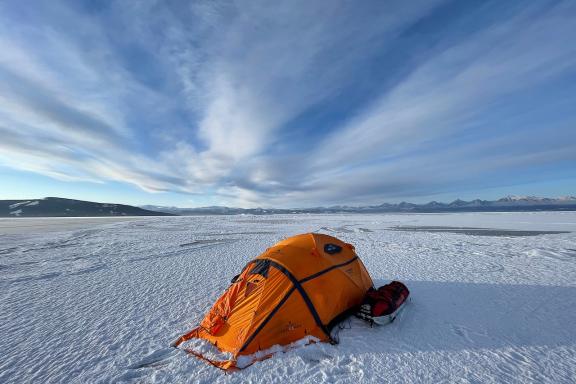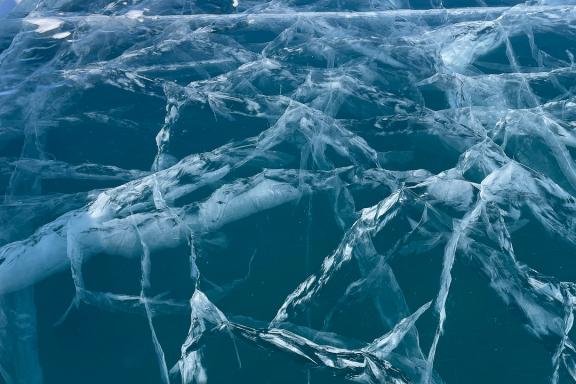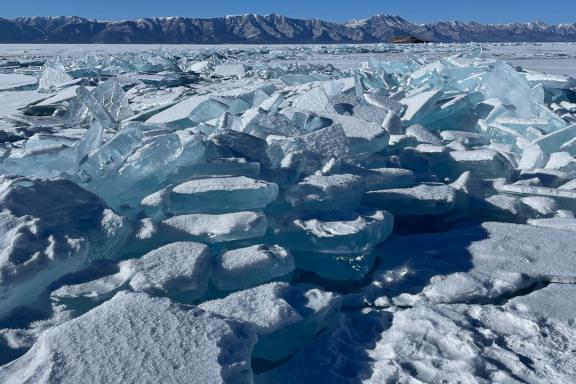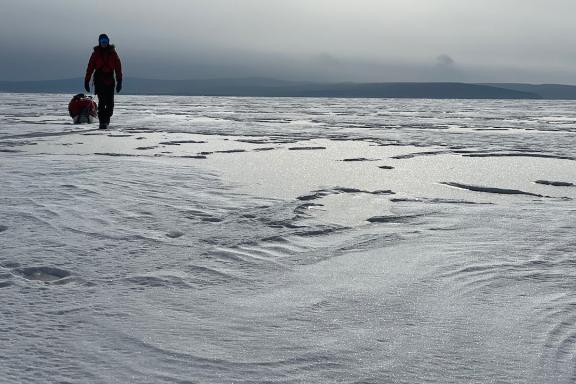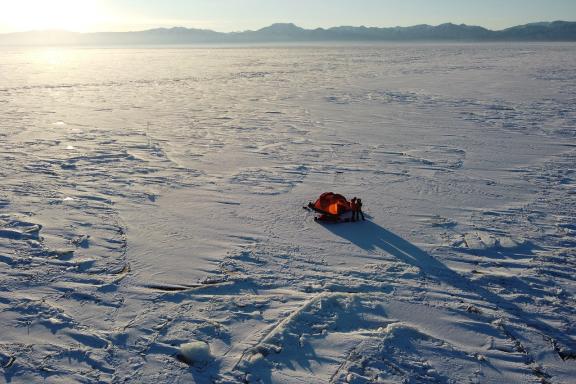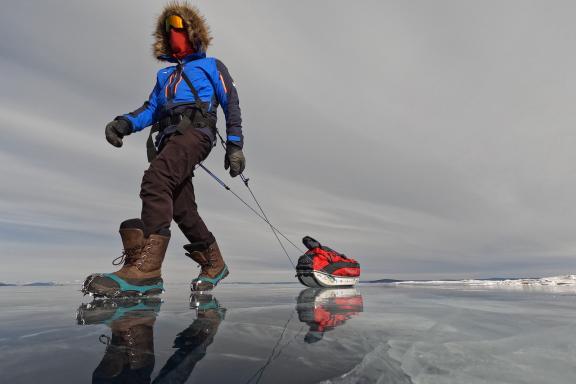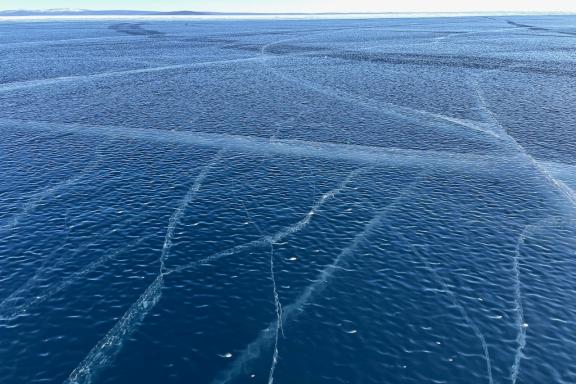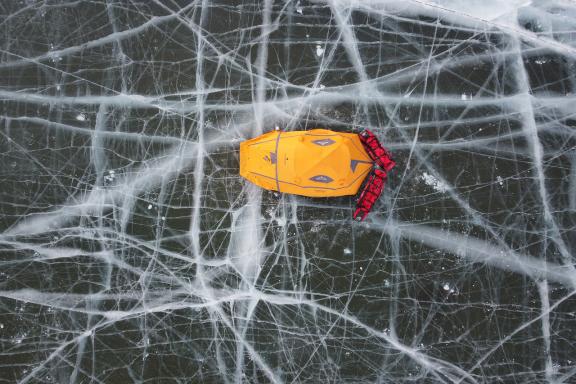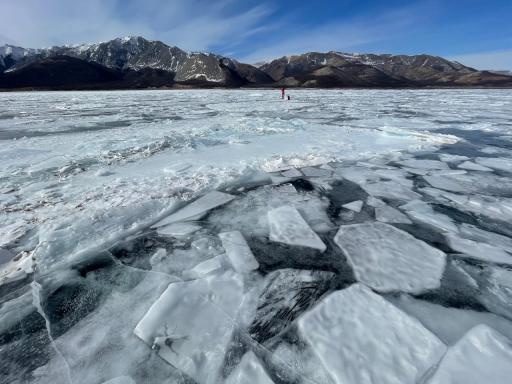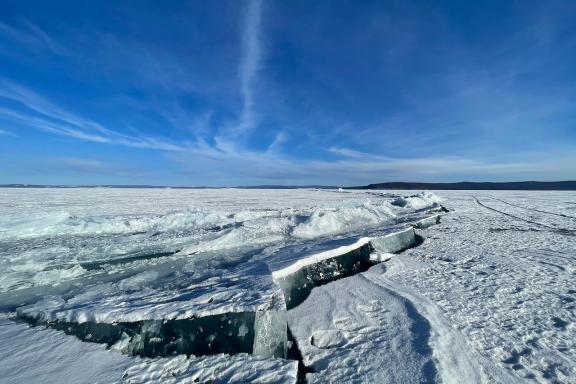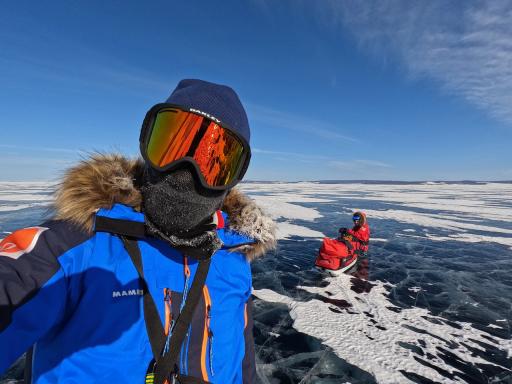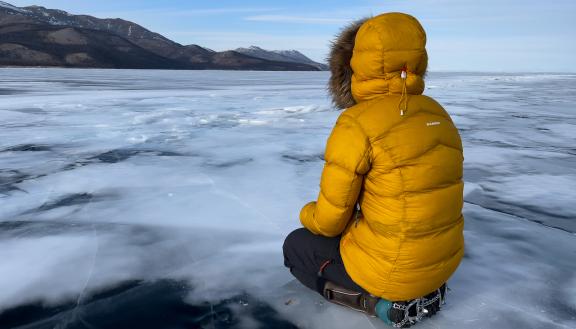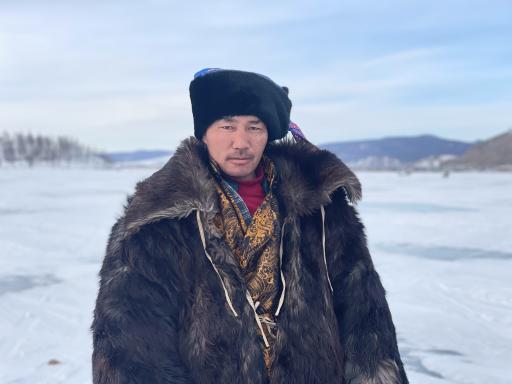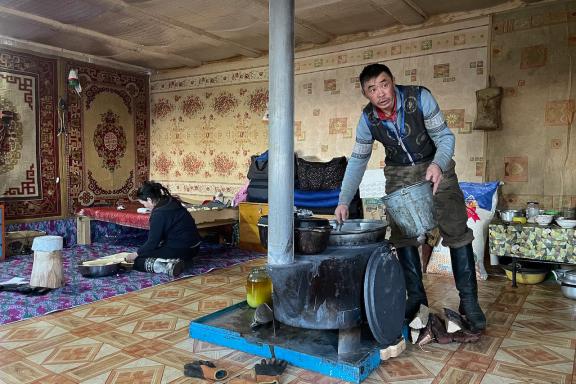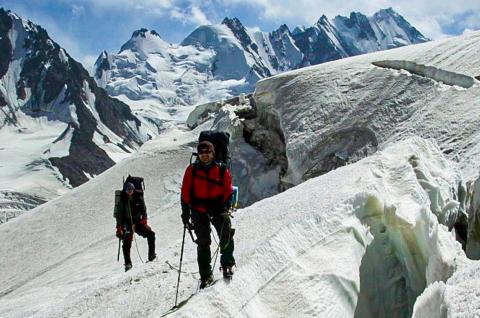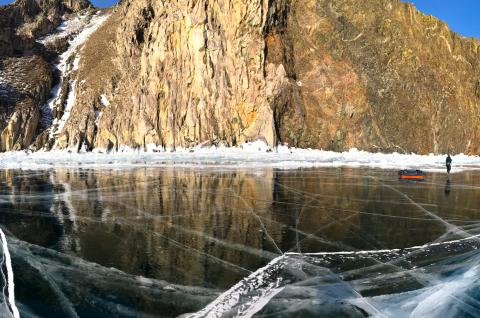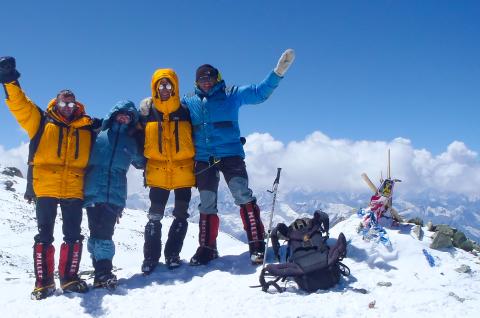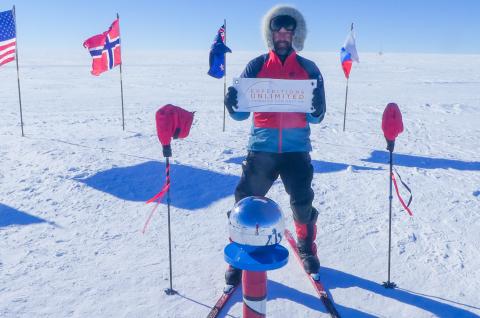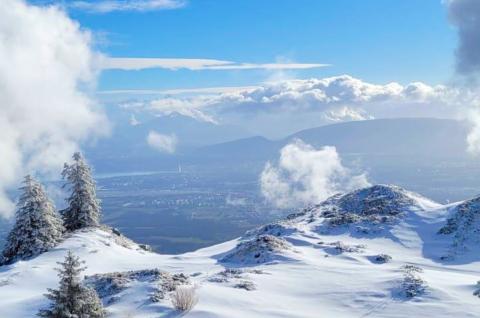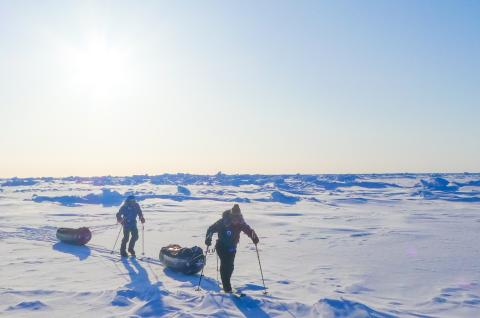Expedition into the frozen wilderness
Highlights
- An original expedition to the heart of nature's exceptional beauty
- Expedition accompanied by an expedition leader from Expeditions Unlimited
- Bivouacs on the ice and encounters with reindeer herders on the riverbanks
- Intimate group of 4 to 6 participants
- H24 Personalized weather forecast services and doctor specialized in polar environment
- A human adventure above all
Led by an Expeditions Unlimited expedition leader, we set off with our crampons and pulkas for an original expedition in northern Mongolia on Lake Khovsgol (or Khuvsgul). We alternate between snow and ice, well protected from the cold. Self-sufficient, we pull our sleds over an itinerary of around 110 kilometers, spending the nights in tents on the lake ice or with reindeer herders living on the shore. Sometimes we have to cross, or even go around, stretches of compression ridge, where the ice looks like huge pieces of broken glass. This adventure is designed for participants with polar experience or who have already done some winter camping.
Overview
Lake Khovsgol, at an altitude of 1,645 metres, is Mongolia's second-largest lake – 136 kilometers long and 36 wide – and its deepest. Nicknamed "the blue pearl of Mongolia" because its water is as clear as a mountain stream, it flows into the Eg river, then the Selenge and finally the Baikal. It belongs to the same hydrographic system as the Baikal, from which it is only 250 kilometers away, and, like the Baikal, has endemic flora and fauna. It is the country's largest freshwater reserve, representing around 2% of the world's freshwater reserves.
After a stopover in Ulaanbaatar (Ulan Bator), the coldest capital in the world, we head north. We make our way through mostly empty landscapes as far as the eye can see, before reaching the Khovsgol Lake region. The large village of Khatgal, just south of the lake, is our base for checking our equipment and making our final preparations before hitting the ice.
For nine days and eight nights, we live in communion with the lake and its ice. Pulling our pulkas, we make our way through breathtaking, raw and wild landscapes. Our progress is punctuated by the sound of ice cracking under our boots. In the afternoon, we set up camp on the lake, and once our tents are up, silence sets in.
Our aim is to cross the lake from south-west to north-east, keeping as far as possible along the wild west coast.We prefer to spend the nights in bivouacs on the ice, to ensure perfect immersion.Nevertheless, we allow ourselves at least one night with the reindeer herders and their families on the western shore of the lake.
Itinerary
DAYS 1 & 2: INTERNATIONAL FLIGHTS AND ARRIVAL IN ULAANBAATAR (ULAN BATOR)
Day 1
We fly to Ulan Bator (Ulaanbaatar) in Mongolia. Arrival usually in the morning of Day 2. Welcome at the airport by our local team and transfer to the hotel. Ulaanbaatar, the capital of Mongolia, is home to over a third of the country's population, some 800,000 people. Built on the banks of the Tuul River and framed by mountains, Ulaanbaatar is a pleasant city to discover. However, it's advisable to wear masks, as in winter the blue sky is often partially veiled by clouds of exhaust from the coal-fired power plants that supply the city with electricity. In the afternoon, we visit Gandantegchinlin, the Gandan monastery. This Tibetan-style monastery is one of the most important in the country. After suffering extensive damage during the religious purges of 1937, it regained its size and fervor in the 1990s.
DAY 3: ULANBAATAAR — ERDENET
Day 3
In the morning, we load up the vehicle and set off on our long drive north towards Khatgal on the banks of Lake Khovsgol. Gradually, moving away from the capital and civilization, we enter the Mongolian steppe. The landscape, mostly empty of habitation, contrasts with the density of Ulaanbaatar. We stop for the evening and night halfway along the route, in Erdenet. Free time to relax over a local beer or a shot of vodka and chat about the expedition ahead.
DAYS 4: ERDERNET — MORON — KHATGAL
Day 4
In the morning, we load up the vehicles and set off on our journey across the Mongolian steppe to the town of Mörön. Here we cross the Selenge and Khovsgol regions, the most densely wooded in the country, with numerous birches, pines, cedars and larches. We finally reach Mörön, the capital of Khovsgol province, which boasts the tallest trees in Mongolia, some reaching over 40 meters in height. This province is home to an abundance of wildlife typical of the mountainous taiga: deer, wild boar, squirrels, beavers, otters, ermines, martens, sable and wolves. But observing them is difficult.
Mörön refers to both the town and the district that contains it. Situated at an altitude of 1,283 meters on the northern slopes of the Ertchim Mountains, on the banks of the Delgermörön River, it is over 670 kilometers from Ulaanbaatar. It is one of Mongolia's most traditionally shamanic provinces, indeed THE cradle of Mongolian shamanism. Mörön was founded on the site of the commercial suburb adjacent to the former monastery of Möröngiin Khuree, built around 1890 and, before the Revolution, the major religious center of northern Mongolia.
Founded between 1809 and 1811, the Möröngiin Khuree monastery is one of the few remaining vestiges of Mongolian Buddhism. At the beginning of the 20th century, the monastery was home to a population of around 1,300 lamas before being destroyed during the purge of 1937. Between 1937 and 1939, Mongolia was marked by a new series of draconian purges against both the secular and religious “intelligentsia”. In particular, a violent anti-religious campaign was launched to eradicate the Buddhist faith and shamanic beliefs. The country's 700 or so monasteries were set on fire, with lamas held responsible for Mongol resistance to modernization. Thousands of monks were put to death. In 1991, a mass grave of 5,000 skulls was discovered in the north-west of the country. Experts put the figure ten to twenty times higher.
At the end of the day, we reach the small village of Khatgal, located at the southern tip of Lake Khovsgol. Khatgal is the largest settlement, and one of only two on the banks of the lake, along with Khankh to the northeast. Composed of numerous wooden houses arranged between wide, parallel streets, Khatgal is reminiscent of the architecture and atmosphere of Russian villages in Siberia.
DAY 5: FIRST STEPS ON THE FROZEN LAKE
Day 5
Today we begin our crossing of Lake Khovsgol. We get up at dawn to have breakfast and check our equipment in our pulkas. After a ten-minute transfer by vehicle to the banks of the lake, we take our first steps on the ice of our 130-kilometer journey.
Our objective is to walk to the hamlet of Turt, north-east of the lake, just below the village of Khankh. We spend the whole of our journey on the lake, alternating - though not regularly - between nights with local people and camping in tents on the ice, snow or bank.
This first day is an opportunity to get to know our surroundings. We make our way across the lake towing our 30-kilo pulkas. It is a thrill for everyone. Our pace varies according to the snow and ice beneath our feet. In some places, snow of varying depths holds our pulkas in place. Elsewhere, when the lake is covered in fast-moving ice, we move forward more easily. We often find ourselves on alternating patches of snow and ice. Finally, some parts of the lake are covered with compression zones, sometimes covering dozens of square kilometers. These areas of intertwined blocks of ice of varying sizes require us to redouble our efforts, when we don't simply have to go around them to facilitate our progress. Every hour or so, we pause for a few minutes to drink hot tea and nibble on seeds, nuts, cheese or energy bars. The duration of these stops is limited to keep us cool. We do not eat lunch for this reason, and make do with these regular snacks.
Around 4 p.m., we approach the riverbank for our first evening and overnight stay with a herder's family, or in a tent. Settled into the only room in the house if we are staying with a local in a house or yurt, we get to know our hosts. They prepare dinner for us all, around the wood-burning stove. The menu is usually soup and meat. Hard to go without! Meat is a staple food in Mongolia, especially in winter. When it is time to sleep, we spread out our sleeping bags on the ground and quickly fall asleep alongside our hosts.
DAY 6: LEAVING ON AND WITH THE LAKE
Day 6
Waking up early, we have breakfast and pack our gear into the pulkas. It is cold outside, and the temperature contrasts with the often overheated interior. We set off, with only the sound of our crampons cracking on the ice or breaking through the snow. We warm up with the effort, and marvel at the beauty of nature all around us. We are confident in the thickness of the ice beneath our feet. The apprehension that may have gripped us at the start now gives way to the pleasure of evolving in an environment of great beauty. The ice is a constant source of admiration, with its ever-changing colors. As for the compressions, they never cease to amaze us with their shape and volume. If we are lucky, we may even catch a glimpse of a wolf track in the snow - wolves that sometimes cross the lake without posing any particular danger.
Ideally, we stop mid-afternoon on the snow to insulate ourselves from the cold of the ice, and close to an area of compression ridges. Indeed, breaking ice into visible pieces is easier than digging into the uniformity of the lake. We screw pins into the ice to hold our tents in place and set up our mattresses and comforters inside. Then we begin the long process of melting the ice on our fuel-powered stove. A stage that demands our full attention. We dine on a freeze-dried meal under canvas, then soon slip into our sleeping bags for the night. Then we hear the sounds of the lake, bubbles bursting, cracking sometimes very loudly, like whips cracking, gunshots, and the feeling of being close to a huge pot of oil on the stove. It is surprising, fascinating and in no way indicative of danger, but rather of the reaction of ice to temperature differences.
DAY 7: ON THE LAKE TO KHAR UURS
Day 7
Around 4 p.m. on the third day, after 12 to 15 kilometers, we choose a spot to set up our tented camp on the bank of the small Khar Uurs Lake, which is never frozen over. A splendid spot where we can take full advantage of the silence and beauty of the surroundings.
DAY 8: ON THE LAKE TO JIGLEEG
Day 8
After breakfast, we leave our camp and return to the ice. We stop regularly to take breaks, and in the late afternoon, after another day's expedition on the lake, we reach Jigleeg for an evening and a night with a herder's family living in a wooden house.
DAY 9: JIGLEEG — MODON KHUIS ISLAND
Day 9
This day is similar to the previous ones, but takes us towards the center of the lake and ends with the setting up of our camp on the island of Dalan Modon Khuis. This island, measuring three by two kilometers, is located 11 kilometers from the eastern bank of the lake, and about 50 kilometers from our starting point. It is uninhabited and mostly covered in forest.
This stage is subject to change depending on weather conditions and areas covered by compression ridges, making access difficult or impossible. A factor that can vary greatly from one year to the next.
DAYS 10 TO 12: CONTINUING OUR EXPEDITION ON THE FROZEN LAKE
Day 10
These days of progress on the lake are rather similar to the previous ones, except that the landscape changes and becomes more beautiful as we approach the north. Indeed, the mountains close to the Russian border in front of us make the landscape on the horizon fascinating. We also continue to marvel at the beauty of the ice, whose palette of colors never ceases to amaze us. We have also become more accustomed to the conditions of a polar adventure. We have long since settled into our new surroundings, and are thoroughly enjoying our journey on the ice. Depending on the weather conditions, our pace and our state of fitness, our guide adapts the location of the nights, between the ice of the lake and the camps, and one night with the locals on the bank.
DAY 13: ARRIVAL IN TURT — KHANKH
Day 13
This is our last day on foot on the lake. We cover another dozen kilometers, enjoying the sounds beneath our feet. The view around us is as magnificent as ever. In the distance ahead of us, we can see the permanent yurt camp we are heading for. We reach it by mid-afternoon. We can finally wash up and change all our clothes. We can even take advantage of the Russian steam sauna, the banya. Our camp, on a small hill, allows us to enjoy the view over the lake. Here, too, we can take time to look at our photos and celebrate our crossing with a cup of tea or a glass of vodka.
DAY 14: KHANKH — KHATGAL
Day 14
Today we return to our vehicles to reach Khatgal, the starting point of our fabulous adventure. In a private vehicle, we drive over the lake, which we can appreciate in a whole new way. Driving across it is also a wonderful experience. We return to our starting guesthouse in Khatgal, where we settle in for the night.
DAYS 15 & 16: KHATGAL — BULGAN OR ERDENET — ULAANBAATAR (ULAN BATOR)
Day 15
In the morning, we pick up our 4x4 and leave Lake Khovsgol. We begin our return journey towards Ulaanbaatar (Ulan Bator), stopping at Erdenet or Bulgan halfway along the northern route. Erdenet is the capital of Orkhon province and Mongolia's second-largest city. It was the country's first mining center. Once in the capital, we check into our hotel.
DAY 17: ULAANBAATAR (ULAN BATOR) — EUROPE
Day 17
Depending on the flight schedule, transfer to the airport and return flight to Europe.
END OF EXPEDITION
For reasons that cannot be foreseen at this stage, such as unpredictable weather, the physical fitness or lack of fitness of participants or other circumstancess (customs formalities, road conditions, traffic, landslides, force majeure, etc.), your expedition leader may have to adapt the program, if necessary, to ensure the smooth running of your trip. He remains the sole judge and the one who guarantees your safety. Activity times are given as an indication and may vary from one participant to another.
The itinerary for all our expedition programs, or the ascent program for our high-mountain expeditions, are given here as a guide only. They are flexible enough to adapt to weather conditions with a few contingency days. In any case, you should follow the recommendations of your guide, who may suggest that you cancel your expedition due to weather, safety or physical conditions.
It is important to remember that this is a truly unsupported expedition, and that anything can happen. Expeditions Unlimited, your expedition leader, your guide or our local teams can in no way be held responsible.
Any costs incurred as a result of a change in the expedition schedule (extra nights' accommodation, extra flights) will be borne by the participants and not by the organizers. "Contingency days" refer to the expedition in the strict sense of the term (base camp/base camp in the mountains, departure point/exit point on a traverse, etc.).
Any early return of the expedition or of certain members only (early success, abandonment, etc.), generating costs for accommodation, meals, changes to air tickets or other activities not provided for in this program, will be charged in full to the participants.
Trip notes
Guiding
Throughout the expedition, we are accompanied by an Expeditions Unlimited expedition leader and a local Mongolian team who will share their culture and Mongolian way of life with us.
For unpredictable reasons at this stage, like adverse weather conditions, insufficient physical condition of participants, insufficient competencies of participants related to the intended activities, your guide may decide to adjust the intended program and/or activities. At all times, his decision will be final on all matters likely to affect the safety and well-being of the trip.
Difficulty level
Level rated: challenging
This program is designed for participants who take part in a regular sports activity several times a week, including endurance activity.
The main difficulty of this expedition is the potentially extreme weather conditions. The temperature at this time of the year can reach −35°C.
The carrying is provided by the participants in the pulkas which weigh nearly 35 kg at the start. A good physical and mental condition is therefore imperative. Each participant is responsible for the application of safety rules, his equipment and its maintenance, the installation of the camp, the preparation of meals. As always in this type of project, the key to success remains the collective and team spirit.
Participation in one of our seminars or polar courses of our School of Adventure is, if not required, strongly recommended.
Meeting point
We meet with our guide in Ulaanbaatar (Ulan Bator).
Given the diverse origins of the participants on this trip, international outward and return flights are not included in this package. In most cases, we book flights on your behalf to ensure that the whole group arrives at the destination at the same time. We do not charge any fees for these air bookings. Please do not hesitate to contact us. If you book your own tickets, we will advise you on the ideal flight schedule to enable all participants to arrive within a reduced time frame. At the very least, you need tickets that can be modified.
Accommodations
Accommodation in a 3* hotel in a twin or double room in Ulaanbaatar, in a yurt or isba (traditional wooden house) in Khatgal and in a guesthouse in the towns. During our expedition on the lake, nights are spent in bivouacs on the ice, and at least one night is spent with herders on the banks.
Ulaanbaatar: Hotel 3 * Edelweiss (or similar)
Meals
Meals are taken in a hostel or hotel, at the beginning and end of the expedition (not included in this package). During the expedition, meals are pre-prepared in the form of freeze-dried rations. These provide us with all the calories we need for the expedition, and are balanced, light and easy to prepare. When we spend the night on the banks of the lake with the herders, we share their meal.
Transfers / Transport
Transfers to and from Ulaanbaatar airport are by private vehicle. Then by 4x4 from the capital to the lake and back. At the end of our crossing, the return journey from Khankh is also by private vehicle, on the ice of the lake, but taking a different route from the one we took on foot.
Group size
The group is composed of 4 to 6 participants maximum. The number of participants is deliberately limited to allow for greater immersion, to avoid embarrassing our hosts, and to develop freedom and flexibility. However, the maximum number may be exceeded if the last person to register wishes to travel with one or more other people. The services will not be modified, and the conditions of the trip will remain the same.
Equipment
All logistical equipment is provided, including tents and pulkas, as well as collective equipment such as stoves, etc. Your guide is equipped with a satellite phone, geolocation beacon and GPS. We also provide a free extreme-cold sleeping bag (-30°C / -35°C) and mattress. Other personal equipment is not supplied. A complete list is provided below.
Our commitments to sustainable development
Our commitment to a better planet has been a reality since the beginning of our story but we always need to do more and better. Please find out more about our charter and our commitments in terms of sustainable development. We have drafted our charter and take action through six themes on which we act as concretely as possible, most often with you: social equity and cultural respect, preservation of water, waste management in expedition, protection of biodiversity, raise public awareness on these subjects and finally, the optimization and recovery of CO2 emissions.
Regarding carbon emissions, most of which are due to air travel, we calculated and communicated in 2018 on the carbon footprint of each of our programs, expressed in tonnes of CO2.
These calculations made us aware of the importance of the total carbon emissions generated by our activity. Also, we have committed in 2022 to a carbon reduction that we believe is unprecedented in the tourism industry, aiming to reduce the total emissions of our activity by 5% per year, taking 2019 as the reference year (3,430 tonnes of CO2). This commitment is in line with the trajectory of the Paris climate agreements of 2015, the current benchmark. Thus, in 2030, we commit ourselves not to exceed 2,160 tonnes of C02. Thus, our maximum “carbon” budget for 2024 is 2,950 tonnes and for 2025, this budget will be reduced to 2,800 tonnes. And so on until 2030. To find out more about all of our calculations and our commitments in terms of reducing our carbon emissions.
In addition, since 2019, we have been encouraging you when you book for your journey to contribute with a donation to an independent NGO, among the two we have selected that share the commitments made in our charter. We matched the amount of this donation to this program's carbon footprint. Thus, the journey you are considering generates 3,43 tons of CO2, which corresponds to a 100% donation of €103 for an estimated value today of €30 per tonne of CO2. This donation remains of course optional and you can decide to give between nothing and 100% of this amount. Since 2019, including covid years of 2020 and 2021, we have been able to collect thanks to you nearly €7,000 for these associations.
Please do not hesitate to come back to us with any questions you might have regarding this carbon footprint mechanism, our other sustainable développement commitments or even to share with us your experience through a chat or a mail at contact@secret-planet.com.
Expert
Lake Khovsgol is one of the pearls of an extraordinary country. In spring and summer, it attracts visitors from all over Mongolia for its relaxing scenery and clear, clean waters. Despite the difficulties involved, the authorities even remove vehicles from its depths when they pass through the ice in winter. In winter, this expanse of snow and ice is fascinating. While it is vital to be very well equipped to venture onto its surface, the surprises the lake has in store are memorable. Most surprising of all is the diversity of colors and shapes of its ice, far from always being as regular as an ice rink. In places, the ice looks more like huge pieces of broken glass, making it difficult, if not impossible, to progress without a workaround. Sleeping on the surface of the lake means becoming one with it, and discovering the nocturnal sounds of its ice reacting to temperature differences. This self-sufficient expedition is also a chance to discover the life of the Mongolian herders who live on its shores, and with whom we sometimes share our meals and nights. Crossing the Khovsgol is an exceptional, unique and memorable experience.
Polar Experience guiding
This program is guided by a Polar Experience guide, accredited by the IPGA (International Polar Guides Association) with a solid experience in the polar regions and who adhere to a specific working method to help participants achieve their goals on an individual basis. They frequently lead participants in Svalbard, Iceland, Greenland, towards the North Pole, the South Pole and elsewhere in Antarctica like in Queen-Maud Land. Not only are they some of the best polar guides in the world, but they also have first-rate teaching and interpersonal skills, making the experience you are about to have, with and thanks to them, even rarer.
These guides were all trained by our late Dixie Dansercoer, who tragically passed away in June 2021 in Greenland. With many years of polar experience, he had developed a high-level team with a specific approach which can be summarized as follows:
- Respect for the environment: going places and leaving no traces, this is what we implement the best way we can during all our Polar Experience guided trips and expeditions. As expeditions are inherently based on a minimalist’s attitude, we stick to the basics and avoid excesses. Respect for local cultures.
- Safety: our knowledge and know-how has been developed with a major focus on maximum experience and minimal risk for our participants. Preparation and high-quality equipment are obviously two major issues with no compromise. We have as well weather, medical and rescue partners on stand-by 24/7. Your guide has a satellite telephone, an Iridium Go! VHF radio, mountaineering safety equipment, a location beacon, GPS and other equipment necessary for a journey in the best safety conditions.
- Preparation & training: full immersion in physical and mental training, equipment knowledge, First Aid basics, logistical challenges and crisis management. Understanding the environmental, cultural and geographical characteristics of polar environment, learning from pioneering and contemporary expeditions. Preparation calls and expeditions training (theory, practice) over a weekend.
- High quality equipment: constant improvements and customized adjustments for maximum efficiency and performance. Screening of personal clothing and advice on purchase of special polar clothing at partner stores with special discounts.
Julie Brown, Dixie's partner of many years, now leads this dynamic little team.
Each participant receives the useful book, Polar Exploration: A practical handbook for North and South Pole expeditions, hard cover or electronic version, written by Dixie Dansercoer, which is the reference handbook that explains all aspects of polar journeys and expeditions: polar environment, safety, preparation, training and equipment.
Departures and pricing
Please find below all dates and prices for this expedition. Prices are quoted "from" and may be adjusted notably according to the number of participants (see trip notes for details). Please note that dates and prices for years beyond 2024, when given, are for guidance only and are subject to change and readjustment to take account of current economic realities.
No date works for me!
I initiate a new datePrice includes
- Accommodations in Ulaanbaatar (Ulan Bator),in camp in Khatgal and Khankh and in guesthouse in the towns of Erdenet and/or Bulgan within the limit of 7 nights
- Breakfasts in Ulaanbaatar, Erdenet and/or Bulgan, Khatgal and Khankh within the limit of 6 days
- All private vehicle transfers between airport and hotel, start and end of expedition.
- Very experienced polar guide
- Meals in the form of freeze-dried rations during the expedition
- Tents for two people, stoves and fuel
- Pulkas and harnesses, mattresses and extreme-cold sleeping bags
- A security satellite phone (reserved for the guide)
- Experienced and personalized weather forecast services throughout the expedition
- Medical follow-up by Ifremmont during the expedition (see above)
- Preparation meetings face to face and/or remotely
- Expedition live coverage for your community (InReach beacon supply, IridiumGo and subscriptions, LivExplorer service configuration)
Price does not include
- The International return flight to Ulaanbaatar (Ulan Bator)
- Lunches and dinners in Ulaanbaatar
- Any customs taxes upon arrival in Mongolia
- Any taxes for the importation of satellite phones, professional communication equipment and filming of a commercial nature
- Expenses related to an expedition schedule shift (additional nights of accommodation beyond 7 nights, breakfasts beyond 6 days, flights supplements)
- Costs related to an early return of the expedition or of certain members only (early success, abandonment, etc.), generating costs for accommodation, meals, modification of plane tickets or other unforeseen activities in this program
- Tips for the guide, to be shared with the other participants according to your satisfaction
- Hotel nights, full-board and other personal expenses during face-to-face preparation meetings
- Personal equipment (please see equipment list below)
- Drinks and all personal expenses (personal visits, taxis, souvenirs, laundry, etc.)
- Travel and expedition insurance (assistance, evacuation and repatriation)
Your custom expedition
We put our expertise, our knowledge of the terrain, our creativity, our experience, the quality of our guides and the reliability of our partners at your service to build your custom expedition. We can also personalize an expedition to your wishes as soon as you form a "closed" group, whatever the number of participants.
This means that, unless you authorize us to do otherwise, no outside participants join you, and we can personalize your expedition by adapting it to your own pace, with the program extensions you desire, a higher level of comfort, certain activities, other encounters, etc.
Every expedition of this type is subject to a specific quotation. To get in touch with us now, please fill in the short questionnaire below. One of our experts will get back to you to refine your request and make you a proposal.
